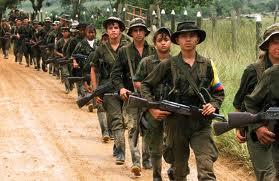Late last week, in just 48 hours, the Revolutionary Armed Forces of Colombia (FARC) delivered two strong blows against the Colombian military, killing 20 soldiers and wounding many others. The timing of the attacks is significant, occurring less than 10 days before the October 30 Colombian local elections.
 The guerrilla raids took place last Friday and Saturday in Tumaco, in the southern department of Nariño close to the Ecuador border, and Tame, in the eastern department of Arauca, near Venezuela. Analysts believe the attacks were a move to influence the up-coming elections of mayors and governors in their bastions in southern and eastern Colombia. The rebel group is expected to launch more attacks in the coming days to demonstrate not only its military strength but also its power play in local electoral politics in the regions of Arauca, Nariño, Meta, Caquetá, Putumayo, and Tolima.
The guerrilla raids took place last Friday and Saturday in Tumaco, in the southern department of Nariño close to the Ecuador border, and Tame, in the eastern department of Arauca, near Venezuela. Analysts believe the attacks were a move to influence the up-coming elections of mayors and governors in their bastions in southern and eastern Colombia. The rebel group is expected to launch more attacks in the coming days to demonstrate not only its military strength but also its power play in local electoral politics in the regions of Arauca, Nariño, Meta, Caquetá, Putumayo, and Tolima.
The attacks are part of an observable trend, over the last year and a half, in which the FARC is attempting to retake the military offensive. The shift is attributed to the “Rebirth Strategy,” launched in 2009 by FARC leader Alfonso Cano, the successor to the long-time FARC leader, Manuel Marulanda, who died in 2008. This new FARC strategy calls for dispersing their troops into smaller guerrilla units, more political activism in areas where they are operating, strengthening their urban militias, and avoiding open confrontation. This new strategy shows the FARC’s capacity to adjust and adapt to the changing war environment and to deal with the new technology employed by the Colombian military and its U.S. ally. Between just January and May the Colombian military suffered 1,115 casualties including dead and injured, which might indicate that this year could be deadlier than 2010 when the military suffered 2000 casualties.
These recent attacks once again demonstrate the continuation of the Colombian war system. Despite employing vast resources in the technology of killing, the Colombian government has been unable to defeat the insurgency. Nevertheless, Colombia’s dominant classes, its military, conservative forces, and of course the United States remain committed to this tunnel vision goal. Consequently, they are missing the point. The solution will not come militarily, but by investing in sustainable development, and redistributing resources such as land. These are cheaper and more profitable, in the longer term, for both the dominant as well as the dominated.
For more from Nazih Richani's blog, Colombian Cuadernos, visit nacla.org/blog/cuadernos-colombianos, or see the NACLA Report July/August 2009, "Coercion Incorporated: Paramilitary Colombia."

